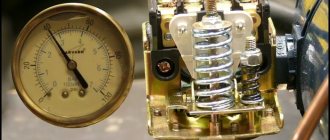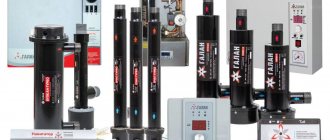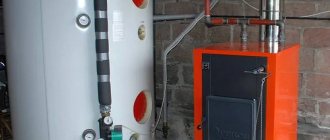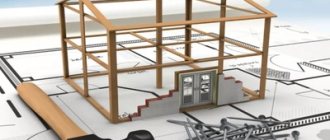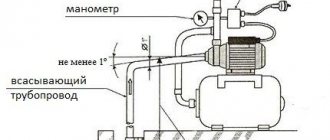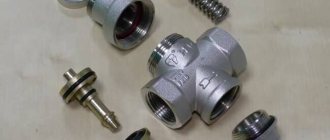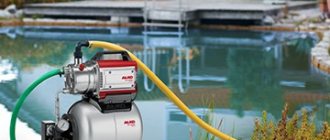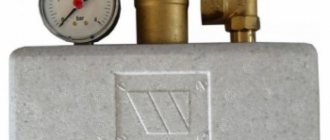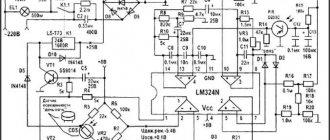When operating a heating boiler, it is necessary to control the pressure: too much can create an emergency situation, and too low will lead to a decrease in the efficiency of the heating. There are various methods of control. They include various types of automation, regulation of water flow into the boiler, control of the heating process of the coolant. The home owner must understand how the heating system works, how to properly regulate the pressure in it, and how the pressure sensor in the heating system works.
Sensors that monitor the operation of the boiler Source stroy-podskazka.ru
Why is it important to control your blood pressure?
For proper operation of the heating system, it is important that the pressure is within certain limits. Otherwise, the process of movement of the coolant through the pipes will be disrupted and the necessary heating of the room will not be provided.
In a heating boiler, the pressure level is related to how heating is carried out. Therefore, a temperature sensor is often used simultaneously with its sensor. If the pressure increases excessively, this can lead to an emergency. When it drops, the heat transfer process will be disrupted due to the slowdown in the movement of the coolant.
The use of an autonomous heating system helps citizens not to depend on a centralized system. This is useful where a private house does not have such an opportunity. Some owners choose this solution in order to save money.
If there are malfunctions, you need to contact a specialist Source priority-perm.rf
In both cases, it is important to achieve savings in fuel consumption. The pressure sensor saves money because it can be used to adjust the heating depending on the temperature and pressure in the boiler. It helps to turn on the pumps only when really needed. This saves energy for their operation and reduces equipment wear.
The sensors in question affect the quality of operation of the entire heating system. It is believed that the functionality of the heating boiler, pipes and radiators determines the efficiency of heating by 80%.
When the boiler functions as a hydraulic accumulator in a private house, water is pumped into it using pumps, which is necessary for consumption inside the house: for working in the kitchen, washing and other functions. If the pumps to ensure the supply of water operate continuously, the pressure in the boiler will increase, which can lead to damage to it or damage to elements of the home water supply network. If the pumping becomes weak, then the water from the tap will have little pressure.
Pressure sensors are connected to relays, which at the right times turn on or off the flow of water depending on the achieved pressure level. The timeliness of these actions ensures that the pressure in the boiler is maintained within the required limits. At the same time, the organization of the optimal mode of use of pumps is ensured.
Pressure sensor device Source crast.ru
Operating and safety features
Thermal sensors help improve the microclimate, but their normal operation depends on following simple rules:
- the element itself that measures room temperatures must be immersed as much as possible in the environment where it is necessary to improve heat transfer;
- Correct and long-term service of the room temperature detector depends on timely inspection and calibration in full accordance with the recommendations from the manufacturers;
- eliminate the negative impact of external factors that may affect the accuracy of temperature measurements for boilers;
- Operation of electrical sensors with damaged insulation is prohibited;
- Do-it-yourself disassembly of the thermostat is strictly prohibited;
- All preventative work is carried out with the equipment disconnected from the 220V network.
Control methods
The state of the heating system can be partially controlled using temperature sensors. They are used to perform various functions. In particular, the pressure in a gas boiler depends on temperature. Using such sensors, you can evaluate the heating efficiency.
However, its use is not enough to regulate the operation of the heating boiler. In this case, the pressure sensor plays the main role. Failure to control the increase in pressure can lead to an accident. Therefore, the installation of such a sensor is necessary. If it is not included in the boiler design, then if there is forced circulation, the owner must install it additionally.
Industrial boiler for heating water Source temron.ru
How to connect a temperature sensor to a boiler
An outdoor temperature sensor for a heating boiler is installed on the outside of the wall of a heated building in compliance with the following requirements:
- the wall should be exclusively north or northeast to avoid direct sunlight. If a hit is still expected, it is necessary to protect the sensor with a visor;
- If possible, it is necessary to avoid installing the sensor in places of high humidity and a high degree of mold formation;
- the wall must have a thickness and degree of thermal insulation sufficient to prevent the sensor from heating up with the heat of the heated room;
- It is also not recommended to install the measuring device near an air conditioner, chimney, exhaust or supply ducts, or any other structures that can affect the measurement results.
The sensor itself is attached to the wall with anchor bolts, for example 5x25, connected to the corresponding connector/terminal of the boiler or thermostat using a two-core cable (cross-section and resistance parameters are indicated in the temperature sensor instructions), the connections are hermetically sealed with a coupling.
Correct installation and connections do not cause any special problems, since detailed algorithms are always described in the instructions.
An example of an installation algorithm from the instructions for the Baxi temperature sensor.
Temperature sensors do not require adjustment or calibration, and their performance and accuracy are tested in practice (at room temperature).
What are pressure sensors used for?
Pressure is influenced by two factors: the flow of water into the boiler and its heating. The maximum permissible pressure should not exceed that which the boiler can withstand. It is desirable that it be less than the limit value by 0.5 atm or more.
The lower value is selected based on ensuring the required degree of heating in the house. In this case, it is necessary that the heating is not turned on too often. Usually in private houses the minimum value is 1.5 MPa and the maximum is 2.5 MPa. However, each time it is necessary to select individually. In this case, the optimal value can be in the range of up to 6 MPa.
Boiler pressure sensor Source teplo-plus.net
Sensors can have different types of designs. The simplest ones are mechanical or electrical. Some are designed to control a relay that closes or opens pipes.
Some varieties are equipped with pressure gauges so that a person can control the pressure level. A mechanism may be provided to prevent sudden changes in water.
It is important that the relay operation frequency is not too high. It depends on the volume of the hydraulic accumulator used in the pressure system and the number of devices consuming water at the moment.
Connecting a pressure sensor Source eteh.com.ua
For example, if in a private house they take a bath, do laundry and wash dishes at the same time, the relay will turn on the pump more often. This is due to higher water consumption than usual. Because of this, the pressure will begin to drop and the relay will operate. As a result, water pumping will begin. Due to the waste of water, the pressure will again drop to the lower limit and the relay will have to turn on the pump again. When the flow rate decreases to the normal value, the operating frequency will return to the normal value.
If the device is equipped with a pressure gauge, the owner can control the pressure level in the system. If it differs from the standard, it will be possible to understand the reasons for what is happening and take appropriate measures.
Heating boiler design Source teplo-teh.com
Connecting an outdoor device
The connection diagram for an outdoor temperature sensor is simple, but requires certain conditions to be met:
- The sun's rays should not fall on the device;
- A non-metallic wall surface for fastening is required;
- The sensor is hung at a height of 2/3 of the building level;
- For accurate operation without interruptions, it is necessary to exclude the effect of aggressive environments and negative factors on the device;
- Do not lay the cable in damp places.
When running a cable along the street, it is necessary to place the wire in a corrugation. When connecting parts, care must be taken; work must be done with the power supply to the equipment turned off.
Features of control of heating boilers
When measuring pressure in heating boilers, two types of sensors are used:
- for steam;
- for water.
Such devices are usually called pressure switches. They have a more complex organization compared to conventional pressure sensors. The sensor readings determine the level of coolant pumping, the operation of fans to cool the boiler, and control the operation of the burners. Pressure switches can be designed to operate with a maximum pressure level, a minimum pressure level, or use a combined approach.
Sensors that monitor gas pressure are designed primarily to control the intensity of water heating. If the pressure is too high, the burners must work less intensely. If it is not enough, you need to heat the water better. When choosing relays for heating boilers, you need to ensure that they correspond to the features of specific models.
When the heating system is operating, the pressure in the system must be within certain limits. It should be such as to ensure normal coolant circulation. If the value goes beyond the limits, then as a result the movement of the coolant may stop.
Heating systems can provide for static or dynamic pressure changes. In the first case, the coolant moves naturally and without the use of pumping. In the second, a higher pressure must be provided at the inlet than at the outlet.
For the boiler to operate efficiently, it is necessary to correctly configure the pressure sensor Source oboiman.ru
Types of temperature sensors
The functioning of the meter depends on the voltage across the diode of the measuring circuit. The temperature change is directly proportional to the diode resistance. The lower the temperature, the lower the resistance, and vice versa.
In thermal power engineering, two types of diesel fuel are mainly used:
- Contact type, when direct contact of the measured medium with the sensor is ensured. For example, in a water or gas environment.
- The non-contact type measures not the temperature environment itself, but the level of heat or cold it generates by measuring the radiation that it emits.
In addition, DTs are divided according to the principle of operation into the following groups of sensors: electronic, electrical, mechanical and resistive. Additionally, DTs are distinguished by placement option:
- overheads, which are mounted to ensure reliable contact on the surface with the medium being measured;
- submersible - located in the thickness of the medium with a measured temperature flow;
- room - air temperature sensor that controls the temperature of internal air in a heated room;
- external - measure the temperature of the external air behind the heated object.
By method of determining temperature
These include the simplest thermocouples, consisting of 2 dissimilar metals that generate electrical voltage in direct proportion to the change in temperature, and an RTD resistive temperature sensor.
This resistor changes its own electrical resistance, which is directly proportional to the change in temperature. Structurally, it is made of a coil with a thin wire wound from copper, platinum or nickel and a ceramic body.
Much less commonly used are manometric temperature sensors that measure the pressure of a gas or liquid medium in a closed vessel.
They are capable of measuring temperature using a non-magnetic method without using a current source, which allows them to be used for remote monitoring. Nevertheless, they have a sensitivity much less than other modifications of DT and have an inertia effect.
Contact sensors
This group of sensors in the boiler is responsible for monitoring the temperature of the heated water in order to prevent it from boiling above 100 C, which is why they are also called overheating sensors. When the limit temperature in the heating circuit is reached, the diesel engine releases the electrical contacts of the shut-off valve, which shuts off the gas supply to the boiler, after which it turns off.
This group of sensors includes special NTC immersion temperature sensors with a “positive temperature coefficient” that monitor the temperature inside the water circuit of a gas boiler. They operate on the basis of thermistors or biometric plates and are well compatible with vacuum sensors in the furnace.
Principle of operation
Water pressure adjustment is carried out in accordance with the following algorithm:
- The taps open. After this, water from the boiler enters the heating system. At the same time, the coolant level decreases, and the pressure also decreases.
- The sensor monitors the pressure so that it does not become too weak. At the moment when the pressure reaches the threshold value, the relay contacts close.
- As a result, a pump is started that pumps water from a well or other external source.
- Due to the influx of water, the pressure will increase. The sensor will monitor when it reaches the maximum permissible value.
- At the moment when this happens, the relay is activated, causing the contacts to open. The pumps now stop working.
Boiler operation diagram Source teplo-klimat.com.ua
As a result, it is possible to maintain pressure within the specified limits. At the same time, it will not fall too much and will not rise so much that there is a risk of an emergency. The sensors not only regulate pressure, but also transmit its value to an external sensor so that the necessary information is available to the master. Periodically turning off the engine prevents it from running idle.
Types of devices for obtaining information about the temperature inside the room
Devices for receiving and transmitting heating indicators are usually divided into:
- by the method of data transmission;
- by method and location of installation;
- according to the data acquisition algorithm.
By data translation method
Based on the method of data transmission, temperature sensors are usually divided into two separate categories:
- using wires;
- having a wireless communication channel.
Now the most popular devices are wireless temperature sensors that transmit information about indoor air heating and water heating using a built-in transmitter. Installation of these devices is allowed both indoors and outdoors.
By method and location
Devices that measure temperature in coolants are also divided according to installation method and mounting location:
- Invoices. They are installed to the thermal circuit of the heating circuit of the room;
- Submersible. Such microsensors come into contact with the coolant (what flows in the heating system);
- Rooms. They are placed inside a heated enclosed space;
- External. Located on the street.
Some devices can combine several types of temperature sensors for more precise heating control.
By method of obtaining evidence
Thermal sensors are also divided according to the method of collecting data. The following types of microsensors are sold on the market:
- bimetallic;
- alcohol
The first type of sensor is a pair of plates made of different metal alloys with an indicator in the form of an arrow. An increase in temperature leads to deformation of one of the plates, which creates pressure on the dial indicator. These devices are distinguished by their accuracy. True, their disadvantages include inertia.
Alcohol heat sensors do not have this drawback. They are sealed flasks with an alcohol solution. When heated, the alcohol expands, which helps set the current temperature. This is a simple and reliable design. True, it cannot be called convenient for tracking indicators.
Types of temperature sensors
To obtain heating data, temperature sensors are used that have different operating algorithms. The most popular types of temperature sensors include the devices listed below.
Thermocouple
This microsensor consists of two connected wires made of two different metals. Due to the resulting temperature difference between the warm and cold ends, a current of 35-65 40-60 μV appears. This indicator will depend on the materials used in the thermocouple.
A thermocouple is a fairly accurate heat sensor used to obtain information about indoor air temperature and heating of coolants. However, its disadvantage is the difficulty of taking indicators.
Video: How to take readings when using a thermocouple
Thermistors
It is much easier to obtain temperature readings using thermistors. These devices are based on the principle of transforming resistance indicators of materials under different heating conditions. These microdevices are not only accurate, but also linear.
Such thermal microsensors can be interfaced with analog-to-digital devices.
Video: how to take readings with thermistors
Digital heat sensor for simultaneous measurements
Digital thermal microsensors have also become widespread. One of the most popular such sensors is DS18B20. This device operates on a microcircuit with three outputs. The device can receive heating data from several microsensors operating in parallel. In this case, the error in the indicators will not exceed 0.5 degrees.
Non-contact thermal imagers and irometers
These microsensors detect thermal radiation emanating from bodies. In order to characterize this phenomenon, a method is used to calculate the amount of energy released over a certain time from the surface of a body per wavelength range. At the same time, they do not come into contact with the thermal fluid.
Quartz temperature transducers (piezoelements)
Quartz thermal transducers (piezoelectric elements) can be used to obtain temperature data in the range from -80 to +250 degrees Celsius. This device works according to the principle of frequency depending on the degree of heating of the quartz element. The operation of the sensor is affected by the placement of the slice along the crystal axes.
Acoustic noise thermal sensors
Heat sensors operate on the principle of obtaining information about the acoustic difference in electrical potentials arising from the heating of resistors. The method of using these devices is extremely simple: the noise emanating from two identical elements is compared. In this case, one of these elements is in previously known conditions of air heating, but the second is not.
Temperature sensors
Nuclear quadrupole resonance thermometers operate on the basis of a field gradient that forms crystal lattices. Also, the operating principle of this device is based on the nuclear moment - an indicator that arises when a charge deviates from the primary spherical symmetry.
The main structural element of these devices is a glass ampoule with a substance placed in an inductive winding connected to a generator circuit.
Semiconductor devices
A separate category of devices that operate according to the principle of changes in p/n junction parameters resulting from temperature exposure. The voltage in this case will be proportional to the temperature effect on the transistors. This helps simplify the calculation of this factor. The main advantage of these devices is high accuracy. Their advantages also include linearity over the entire measuring range.
Volumetric transducers for temperature readings
These devices operate on the simple and well-known principle of changing the volume of substances when they are heated and cooled. These temperature sensors are practical. Their operating temperature measurement range is from -60 to +400 degrees Celsius.
Mechanism of action
The main element of a mechanical sensor is an elastic membrane. On the one hand, it is affected by the liquid in the boiler. It bends, acting on structural elements that allow you to accurately determine the amount of pressure. When the threshold value is reached, the relay performs its intended action - closing or opening the contacts. The minimum and maximum thresholds are set using two springs of different diameters. As soon as the membrane presses on them, the corresponding action is performed.
A mechanical pressure sensor in a heating system can also have the following operating scheme. It is mounted so that water enters the cylindrical hole.
It will put pressure on the elastic membrane, which will bend under the influence of pressure. Behind the membrane there is a conductive metal disk, which will be displaced by a greater amount, the stronger the liquid acts on the membrane.
Sensors must be easily accessible Source sovet-ingenera.com
There are protruding parts along the edges of the disk. When the disk advances, the contacts are closed. This will turn on the relay. If the pressure decreases, the curvature of the membrane will decrease and the disk will open the circuit. As a result, the relay will turn off.
In this way, the pumps will be turned on or off depending on the presence of a certain pressure in the boiler. The disk may have two pairs of protrusions of different sizes. Depending on the degree of exposure to water, the connection of different contacts will occur at different pressure values.
The electrical sensor uses a different operating principle. Here the main element is still the membrane, but its deformation is converted into an electrical analog signal. Next, it is strengthened to the desired level. Then it is converted into a discrete form. It is supplied to the control unit, which, depending on its value, supplies the corresponding control signal intended to close or open the contacts.
There are also electromechanical devices. They must include a pressure gauge. However, it uses three arrows. Two of them indicate the minimum and maximum pressure values, and one indicates its current value. When the parameter reaches a critical value, the circuit closes and, as a result, a command is given using a relay to turn the pumps on or off.
Heating system in a private house Source aqua-rmnt.com
Typically the membrane is located inside a tube of circular or elliptical cross-section. It shifts from the pressure in the boiler and affects the pressure gauge readings and the operation of the relay. When choosing mechanical sensors, the following requirements must be taken into account:
- It is important to consider measurement error. It should not be so large that it distorts the results.
- When choosing a household pressure gauge, the accuracy class should not be lower than 2.5.
- It must be remembered that the sensor is used in intensive mode. As a result of prolonged use, the instrument's readings may become less accurate.
It is recommended to calibrate the sensor before the start of each heating season.
The advantages of mechanical type sensors are affordable cost and higher reliability. Electric ones provide better functionality. For example, here you can organize a connection after an emergency shutdown has occurred. Some models provide transmission of signals to the owner's mobile phone.
Pressure sensor with a relief valve Source otivent.com
It should be borne in mind that there are other types of sensors under consideration, but they are relatively rare. An example is liquid devices. This scheme uses the principle of communicating vessels. In this case, the liquid inside the boiler is discharged outside into a vertical transparent tube.
Depending on the height to which it rises, one can judge the amount of pressure. This method is highly accurate, but it is usually used only in laboratory conditions.
Differential type devices are also used. Here, two cameras are used for measurement, the connection between which is made in the form of a sensitive element. Typically, such measuring instruments are used as remote ones.
Multifunctional electronic boiler pressure and temperature control system Source owen.ru
Types of devices for taking temperature
Thermal devices can be classified according to a number of important criteria, including the method of transmitting information, the location and conditions of installation, as well as the algorithm for taking readings.
By method of information transmission
According to the method of transmitting information used, sensors are divided into two large categories:
- wired devices;
- wireless sensors.
Initially, all such devices were equipped with wires through which thermal sensors communicated with the control unit, transmitting information to it. Although such devices have now replaced their wireless counterparts, they are still often used in simple circuits.
In addition, wired sensors are more accurate and reliable in operation.
To ensure consistent operation of a wired sensor used in a composite device, it is advisable to combine it with equipment that is made by the same manufacturer
Currently, wireless devices have become widespread, which most often transmit information using a radio wave transmitter and receiver. Such devices can be installed almost anywhere, including a separate room or open air.
Important characteristics of such temperature sensors are:
- presence of battery;
- error of measurements;
- signal transmission range.
Wireless/wired devices can completely replace each other, but there are some peculiarities in their functioning.
By location and method of placement
Based on the mounting location, such devices are divided into the following types:
- overheads attached to the heating circuit;
- submersible, in contact with the coolant;
- indoor, located inside a residential or office space;
- external, which are located outside.
Some units may use several types of sensors simultaneously to control temperature.
According to the mechanism for taking readings
According to the method of displaying information, devices can be:
- bimetallic;
- alcohol.
The first option involves the use of two plates made of different metals, as well as a dial indicator. As the temperature rises, one of the elements is deformed, creating pressure on the arrow. The readings of such devices are characterized by good accuracy, but their big disadvantage is their inertia.
Bimetallic and alcohol thermostats are often installed on heating equipment, such as boilers. They allow you to monitor heat, exceeding which can lead to fatal consequences.
Sensors whose operation is based on the use of alcohol are almost completely free from this drawback. In this case, an alcohol-containing solution is poured into a hermetically sealed flask, which expands when heated. The design is quite elementary, reliable, but not very convenient for observations.
Installation location
When water enters the boiler, filter elements are located after the tap. The pressure sensor is usually mounted between them. This is due to the fact that pressure surges occur less frequently in this location. When installing, you must take into account the operating requirements specified in the instructions. For example, some types of relays can only be used indoors. Tees are used for connection. They make it possible to connect not only a sensor to the boiler, but also a pressure gauge.
The connection location is selected depending on the technical features of the device. In some cases, it is more advisable to install the relay directly on the water pump in the well. In this case, they must be placed in a moisture-proof housing. To install an electrical type sensor, you will need to connect an electrical cable for power.
Its thickness must correspond to the power of the pumping equipment. For example, if it is 2 kW, then the cable cross-section should not be more than 2 square meters. mm. After completing the connection, you need to check the functionality of the structure. To do this, turn on the pump and check the pressure. If the installation was carried out correctly, then it should increase.
Heating system in a private house Source project-home.ru
How to choose a remote temperature sensor
The choice depends on how the sensor will interact with the boiler: directly or through a thermostat.
Connected directly to the boiler
The choice here is small: as a rule, these are 1-3 models developed by the same manufacturer as the boiler. Their compatibility with specific models or lines of boiler models is indicated in the technical specifications and instructions. The cable for connecting the temperature sensor to the boiler (usually two-core with a cross-section of 0.5 mm2) must be purchased separately. The exact requirements for cross-section and resistance are indicated in the sensor instructions.
Connectable to thermostat
External temperature sensor for the Gira 130200 thermostat.
In rare cases, an outdoor sensor is included with a room thermostat, but most often a sensor for measuring the temperature of heated floors is included in the kit. To take into account the outdoor temperature, universal outdoor temperature sensors are connected to the thermostat: from Gira, Tim, Shuft (ATF2-NTC10K) or Teplolux (TST02). It is important to pay attention to:
- range of measured temperatures - for example, for Teplolux TST02 it is from +5 to +45 ° C, which is not applicable in the cold season;
- degree of moisture protection;
- measurement accuracy/error – an error of +-1°C is considered acceptable, a good result is +-0.5°C;
- cable length - as a rule, a 2-6 m long cable is already connected to the temperature sensor.
Adjusting parameters
When purchasing a sensor, the owner can proceed in various ways. It can leave the factory settings. This makes sense in cases where the pump operates under standard conditions.
If the design used has its own characteristics, then it is better to configure it yourself. How to do this is described in detail below.
After installation, it is necessary to adjust the minimum and maximum pressure values. It is important that the difference between them is approximately 1 atm. Before making adjustments, perform the following steps:
- All pump elements are disconnected from the network. Now you need to completely drain the water from the pump.
- You need to check the pressure level in the boiler. To do this, you can use any available pressure gauge.
- It is necessary that the pressure be equal to 1.5 atm. If it is less, you need to pump up water.
- If it is exceeded, you need to lower it by pressing the nipple.
Electronic pressure switch Source kty.com.ua
After the boiler has been prepared, it is necessary to begin the adjustment procedure. Here, as an example, we consider a mechanical type sensor. The adjustment is carried out as follows:
- To begin the adjustment procedure. The pump must be turned off. Then drain the water completely. Check the pressure gauge readings. It should show zero value.
- Start filling the boiler with water. When the process is completed, it is necessary to measure the pressure again. This value must be fixed.
- Now you need to drain the water to get the minimum pressure value. It is also fixed.
- Using a nut, the springs are approximately adjusted so that they correspond to the desired value. Weaken a spring with a smaller diameter. Using a nut, the compression of a larger diameter spring is adjusted. It must be remembered that when tightening it increases the minimum response pressure, and when unscrewing it decreases it.
- Fill the system with water, then drain it. It is necessary to determine the moment when the pump will automatically turn on. If it is more or less than required, additional adjustment of the spring is carried out.
- Start adjusting the spring with a smaller diameter. It is tightened to set the value at which the pump will turn off. Compression will lead to a decrease in the difference between the maximum and minimum pressure values, and weakening will lead to an increase in this parameter.
- Check the set values. To do this, start the pump and determine at what pressure value the shutdown will occur.
- If the maximum value is not set accurately, then by tightening or unscrewing the nut, adjust the degree of compression of a small diameter spring until the parameter is set accurately.
When the pressure thresholds are accurately set, the adjustment procedure is completed.
Gas boiler pressure switch Source stroy-podskazka.ru
Prices for popular sensors
| Manufacturer and model | Peculiarities | Cost, rub. | Our rating, 0-5 points |
| BAXI KHG | Mechanical, inexpensive and reliable | 1 350 | 3,9 |
| TEPLOCOM TS-Prog-2AA/8A | Programmable, wired, functional, best in price-quality ratio | 3 300 | 4,5 |
| TEPLOCOM TS-Prog-2AA/3A-RF | Programmable, wireless, functional, expensive | 5 500 | 4,3 |
| TEPLOLUX MCS-350 | Programmable, wired, functional, with Wi-Fi module and touch display, with additional. sensor, modern stylish design | 5 100 | 4,9 |
Selecting a sensor when purchasing
It is important to clarify for what operating pressure range it is intended. This data can be found in the technical data sheet of the device. If the range is not sufficient for this boiler, then it is better to look for another sensor model.
In this case, it is necessary to provide for a gap of 0.5 atmospheres. By this value, the limit value with which the sensor can operate must certainly exceed the maximum permissible value for the accumulator.
In most cases, a measuring range from 0 to 4 bar is sufficient for home pressure gauges. If we are talking about industrial use, then we can talk about higher pressure.
Various models of pressure sensors Source thermoexpert.ru
It is necessary to take into account the diameter of the fitting for fastening. Previously, most of these devices had a diameter of 0.25 inches. Now the production of devices with 0.5-inch fittings has increased.
It is important that the pressure gauge is installed in such a place that it is easily accessible. The pressure sensor must be suitable for the operating conditions. For example, some applications may require pressure gauges designed to operate in high or low temperature environments.
Each measuring device has a specified testing frequency. It is advisable to choose a model so that monitoring of correct operation is required less frequently.
Connecting a pressure sensor Source stroyfora.ru
Depending on the principle of operation of the device, its characteristics will differ. The most common sensors are those that use springs. This is due to the fact that they provide acceptable accuracy, but are affordable. Membrane devices provide higher accuracy, but also cost more. Electrical devices provide high-quality control, but are much more expensive, so they are rarely used in private homes.
It must be taken into account that the number and location of sensors should be determined by the boiler usage pattern. In some cases, you can limit yourself to installing one instance, and sometimes you may need more. In simple cases, if the boiler is used as a simple source of water raised to the desired height, then you can simply pump water by turning the pump on and off manually.
If we are talking about a heating boiler, then monitoring the pressure in the boiler is vital. Uncontrolled heating of the coolant will lead to an emergency. In such cases, an automated control system for heating and pump operation is created. This is especially important if there are two or three heating circuits.
When defining parameters, different units of measurement are used. In order to navigate them well, you need to know how to determine the relationship between them. 1 bar is equal to 0.99 atmospheres. When giving figures using megapascals, it must be taken into account that there are 10 bar in 1 megapascal.
Correct adjustment of sensor parameters is necessary for uninterrupted operation Source strojdvor.ru
Criterias of choice
The selection of a temperature sensor should be carried out taking into account the following criteria:
- range of measured temperatures, the sensor must be as sensitive as possible and respond to heating changes with minimal delay,
- technical features of the installation: submersible or fixed, is there enough space for installation, etc.,
- measurement conditions under which it is possible to minimize negative influencing factors,
- characteristics of the sensor: the need for voltage supply, the speed of the transmitted signal, the measurement error, the admissibility of operation in specific conditions,
- service life, maintenance periods, need for calibrations,
- output signal value.
Immersion temperature sensor for boiler
Sudden drop in pressure
When measuring pressure in the heating system, the owner may encounter emergency situations. One of the most common is sudden changes in pressure. In these situations, automatic adjustment will not be enough. It is necessary not only to find out that a difference has occurred, but also to determine its cause. The most common are the following:
- There is a malfunction of the pumps used. The automatic adjustment system is built on the basis that they work normally, but in an emergency an unpredictable situation will actually arise.
- The appearance of a leak in the accumulator. It will provide a constant decrease in pressure, which will lead to constant operation of water pumps or to heating of the heating boiler above a critical level.
- Random failure of the settings used by the pressure sensor.
- Damage to the boiler shell. For example, microcracks may form. This dramatically reduces the strength of the equipment and increases the risk of an emergency.
- If direct control is carried out via an electronic board, then its failure is possible. In this case, for repairs you will need to contact specialists or replace with a new one.
- A sudden shutdown of heating or pumps may occur, after which the switching on does not occur for a long time. This is usually due to a malfunction of the relay.
- For the equipment to function properly, it is important that the power supply meets the required parameters. Electrical devices may malfunction due to power surges or sudden shutdowns.
These reasons are the most likely, but other options are also possible. If pressure surges are detected, the following should be done to analyze the situation:
- First you need to make sure that all connections are tight.
- It is necessary to carefully visually inspect all elements of the structure one by one and make sure there is no damage.
- If you shut off the valves one by one and monitor this using the pressure gauge readings, you will be able to determine the expected location of the malfunction.
If an unreliable connection is detected, it must be sealed and then tightened. If repair cannot be achieved, the problematic parts must be replaced. If microcracks are detected, installation of a new unit is mandatory.
Sometimes problems with pressure regulation are associated with a broken or malfunctioning sensor. Often in this situation the cause is due to damage to the membrane. During inspection, it is necessary to check the power supply connection.
The water pressure in the system must comply with the standards Source sovet-ingenera.com
Malfunctions
High-temperature operating conditions of the sensors, especially during unstable boiler operating conditions, lead to the fact that the primary meters fail. The boiler will often shut down if the thermocouple fails periodically, or diagnostics of the boiler operation will signal an error, and the instruments may show an “open circuit.”
Steps to troubleshoot a faulty temperature sensor:
- To repair the diesel engine, I check the correctness of the -ve and + ve conclusions
- I make sure that the cable is installed in accordance with the manufacturer's recommendations.
- I check that there are no external heat sources that could distort the DT readings.
- I check the temperature regulator setting.
- I diagnose possible interruption errors.
- I inspect the sensor for damage.
- I check the faulty thermocouple with a multimeter.
The temperature sensor is the main meter in the boiler safety and control system. It not only performs a protective function, but also contributes to up to 30% savings in thermal energy and gas consumption, since it does not allow overheating and boiler cycling.
Modern Russian requirements for the operation of household boilers oblige all boiler manufacturers to install diesel engines in the safety and protection system; it is better if this work is performed directly at the factory.
Strong increase in pressure
Unnecessarily high pressure increases the risk of an emergency. The most likely reasons for this situation are:
- Random formation of air pockets in pipes.
- During operation, gradual contamination of pipes and filters occurs. They need to be cleaned regularly and replaced if necessary. If this is not done on time, it leads to increased pressure.
- In case of a malfunction of the pressure regulator.
- The pumps are not switched off regardless of the relay signals.
- In case of complete shut-off valve closure.
If the cause of the problem is an air lock, then you must first bleed the water and then begin normal operation of the system.
If the filters are dirty, they need to be cleaned. Pipes will function normally only if they are cleaned regularly. Sometimes it is impossible to remove contaminants in pipes. In this case, it will be necessary to replace the corresponding section of the system.
Hydraulic accumulator for water supply systems Source art-liga.rf
If, after diagnosing the system, it becomes clear that the cause of the problem is the regulator, then you need to check the correctness of its settings. If necessary, it is necessary to re-calibrate and set the parameters.
The occurrence of problems with the power supply may, for example, be associated with power outages or sudden surges. In this case, care must be taken to install appropriate devices to ensure uninterrupted power supply.
When the regulator is controlled by an electronic board, sudden voltage surges can damage it. It is necessary to check the functionality of the device and, if necessary, replace it.
In some cases, an increase in pressure occurs due to the complete closure of shut-off valves. If a problem situation arises, you need to check the condition and, if necessary, open them.
Automation for heating systems - temperature control sensors simplify its regulation
At times, people are faced with the need to set the temperature regime for each room in an apartment or house. To solve this problem, you can install a temperature sensor on the heating battery. With the help of such a small device, the operating mode of heating system batteries is set. Similar devices are used with any type of radiators, except cast iron.
It is important to take into account that with the help of this device the heating of the room can always be reduced. Increasing the heating of the room with the device is only possible if the heating system has sufficient power.
conclusions
Connecting sensors to Arduino is the transformation of an algorithmic robot, controlled automatically or manually, into a full-fledged environment for the interaction of devices and circuits with the environment. Do not forget - this is not a panacea for all ills. And not the final high-tech product or the final application. Arduino is a set of hardware and software solutions that will help:
- master algorithmization systems for novice engineers;
- master basic design skills;
- learn to program.
Regardless of your level of training, your knowledge, you can always choose tasks within your capabilities. You can put together a simple solution to automate some simple task without soldering together with a schoolchild; Or you can set a global task, which requires, in addition to knowledge and logic, the ability to solder efficiently and correctly draw and read drawings. And active communities, forums and knowledge bases on the Arduino system will help solve almost any issue.
Do-it-yourself installation recommendations
Such devices are widely used for various purposes: they are equipped with radiators, heating boilers and other household appliances.
Before starting installation, you should carefully read the instructions: it indicates not only the installation features (for example, dimensions for connecting to the pipe), but also the operating rules, as well as the temperature limits for which the measuring device is suitable.
It is also necessary to take into account the size of the sleeve, which can vary between 120-160 mm.
Let's consider the two most common cases of installing a temperature sensor.
Connecting the device to a radiator
It is not necessary to equip all heating devices with a thermostat. According to the regulations, sensors are installed on the battery if its total power exceeds 50% of the heat generated by similar systems. If there are two heaters in the room, then the thermostat is installed only on one, which has a higher power rating.
The temperature sensor is a mandatory component of temperature controllers that allow you to reduce or increase the heating of radiators, heated floors and other heating devices
The device valve is installed on the supply pipeline at the point where the radiator is connected to the heating network. If it is impossible to insert it into an existing chain, the supply line must be dismantled, which can cause some difficulties.
To carry out this manipulation, you need to use a tool for cutting pipes, while installing a thermal head can be easily done without special equipment. As soon as the sensor is mounted, it is enough to align the marks made on the body and the device, after which the head is fixed with a smooth hand press.
OneWire library for working with DS18B20
The DS18B20 uses the 1-Wire protocol to exchange information with Arduino, for which an excellent library has already been written. You can and should use it so as not to implement all the functions manually. You can download OneWire here. To install the library, download the archive and unpack it into the library folder of your Arduino directory. The library is included using the #include command
Basic OneWire library commands:
- search(addressArray) – searches for a temperature sensor; if found, its code is written to the addressArray array; otherwise, false.
- reset_search() – a search is performed on the first device.
- reset() - Perform a bus reset before communicating with the device.
- select(addressArray) – the device is selected after the reset operation, its ROM code is written.
- write(byte) – a byte of information is written to the device.
- write(byte, 1) – similar to write(byte), but in parasitic power mode.
- read() – reading a byte of information from the device.
- crc8(dataArray, length) – calculation of the CRC code. dataArray – selected array, length – code length.
It is important to set the power mode correctly in the sketch. For parasitic power, in line 65 you need to write ds.write(0x44, 1);
For external power, line 65 should be written ds.write(0x44).
Write allows you to send a command to the temperature sensor. Basic commands given in the form of bits:
- 0x44 – measure the temperature, write the resulting value to SRAM.
- 0x4E – Write 3 bytes to the third, fourth and fifth bytes of SRAM.
- 0xBE – sequential reading of 9 bytes of SRAM.
- 0x48 – copying the third and fourth bytes of SRAM to EEPROM.
- 0xB8 – copying information from EEPROM to the third and fourth bytes of SRAM.
- 0xB4 – returns the power type (0 – parasitic, 1 – external).
Characteristics of the lm35 sensor, description
— power: 2.7-5.5 Volts; — current consumption: 50 mkA; - temperature range: 10°C - 125°C - error: 2 degrees.
Instead of lm35, you can use any other temperature sensor, for example, TMP35, LM35, TMP37, LM335. The sensor looks like a transistor and is therefore easy to confuse, so always carefully read the markings on the radio elements. Manufacturers often make temperature modules for Arduino based on this sensor (see photo above). If you only have the lm35 sensor itself, then it has three outputs.
LM35 connection circuit, how it works (datasheet)
If you look at the lm35 temperature sensor from the side of the contacts and cut upward (as in the figure), then on the left there will be a positive contact for power supply of 2.7-5.5 Volts, the contact in the center is the output, and on the right is the negative power contact (GND) .
Installing a heated floor temperature sensor
Installation of a heated floor temperature sensor is carried out in several stages:
- Installation. Produced at a height of 1 meter from the floor level. This is an approximate indicator - it can be a little higher or lower;
- Grooving. Special channels are made in the floor and wall through which cables will be laid connecting the regulator and temperature sensors;
- Wiring installation. Wires are installed in the grooves, secured with special clamps. They are pre-placed in a protective corrugation, which prevents damage to the insulation.
Warm floor in the bathroom Source skladpolov.com.ua
Application
The scope of application of temperature sensors covers both household appliances and equipment for general industrial use, the agricultural industry, the military industry, and the aerospace sector. Each of you can find them at home in heating appliances - boilers, ovens, multicookers or bread makers.
In heavy industry, thermal sensors make it possible to control the degree of heating of furnaces, air in the working area, and the condition of rubbing surfaces. In medicine, they are used to control temperature in hard-to-reach places or to simplify various procedures.
Many car enthusiasts often come across temperature analyzers that monitor the condition of oil or other coolant. On the railway network, they make it possible to monitor the heating of axle boxes and wheel sets. In the energy sector, they are used to examine contact connections and the quality of surface contact.
